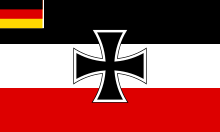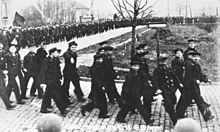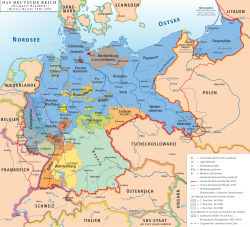
A | B | C | D | E | F | G | H | CH | I | J | K | L | M | N | O | P | Q | R | S | T | U | V | W | X | Y | Z | 0 | 1 | 2 | 3 | 4 | 5 | 6 | 7 | 8 | 9
German Reich Deutsches Reich (German) | |||||||||
|---|---|---|---|---|---|---|---|---|---|
| 1918–1933[1][2][3] | |||||||||
Flag
(1919–1933) Coat of arms
(1928–1935) | |||||||||
| Motto: Einigkeit und Recht und Freiheit ("Unity and Justice and Freedom") | |||||||||
| Anthem: Das Lied der Deutschen "The Song of the Germans" (from 1922)[4] | |||||||||
| Capital and largest city | Berlin 52°31′N 13°23′E / 52.517°N 13.383°E | ||||||||
| Official languages | German | ||||||||
| Common languages | Unofficial: | ||||||||
| Religion | 1925 census:[5]
| ||||||||
| Demonym(s) | German | ||||||||
| Government | Federal representative semi-presidential republic
| ||||||||
| President | |||||||||
• 1919–1925 | Friedrich Ebert | ||||||||
• 1925–1933 | Paul von Hindenburg | ||||||||
| Chancellor | |||||||||
• 1919 (first) | Friedrich Ebert | ||||||||
• 1933 (last) | Adolf Hitler | ||||||||
| Legislature | Bicameral | ||||||||
| Reichsrat (de facto) | |||||||||
| Reichstag | |||||||||
| Historical era | Interwar period | ||||||||
• Established | 9 November 1918 | ||||||||
| 11 August 1919 | |||||||||
• Admitted to the League of Nations | 8 September 1926 | ||||||||
• Rule by decree begins | 29 March 1930[6] | ||||||||
• Hitler inaugurated Chancellor | 30 January 1933 | ||||||||
| 27 February 1933 | |||||||||
| 23 March 1933[1][2][3] | |||||||||
| Area | |||||||||
| 1925[7] | 468,787 km2 (181,000 sq mi) | ||||||||
| Population | |||||||||
• 1925[7] | 62,411,000 | ||||||||
• Density | 133.129/km2 (344.8/sq mi) | ||||||||
| Currency |
| ||||||||
| |||||||||
| Today part of | |||||||||
| History of Germany |
|---|
 |
The Weimar Republic,[d] officially known as the German Reich,[e] was a historical period of Germany from 9 November 1918 to 23 March 1933, during which it was a constitutional federal republic for the first time in history; hence it is also referred to, and unofficially proclaimed itself, as the German Republic.[f] The period's informal name is derived from the city of Weimar, which hosted the constituent assembly that established its government. In English, the republic was usually simply called "Germany", with "Weimar Republic" (a term introduced by Adolf Hitler in 1929) not commonly used until the 1930s.
After the end of the First World War (1914–1918), Germany was exhausted and sued for peace in desperate circumstances. Awareness of imminent defeat sparked a revolution, the abdication of Kaiser Wilhelm II, formal surrender to the Allies, and the proclamation of the Weimar Republic on 9 November 1918.[8]
In its initial years, grave problems beset the Republic, such as hyperinflation and political extremism, including political murders and two attempted seizures of power by contending paramilitaries; internationally, it suffered isolation, reduced diplomatic standing and contentious relationships with the great powers. By 1924, a great deal of monetary and political stability was restored, and the republic enjoyed relative prosperity for the next five years; this period, sometimes known as the Golden Twenties, was characterised by significant cultural flourishing, social progress, and gradual improvement in foreign relations. Under the Locarno Treaties of 1925, Germany moved toward normalising relations with its neighbours, recognising most territorial changes under the 1919 Treaty of Versailles and committing never to go to war. The following year, it joined the League of Nations, which marked its reintegration into the international community.[g][9] Nevertheless, especially on the political right, there remained strong and widespread resentment against the treaty and those who had signed and supported it.
The Great Depression of October 1929 severely impacted Germany's tenuous progress; high unemployment and subsequent social and political unrest led to the collapse of Chancellor Hermann Müller's grand coalition and the beginning of the presidential cabinets. From March 1930 onwards, President Paul von Hindenburg used emergency powers to back Chancellors Heinrich Brüning, Franz von Papen and General Kurt von Schleicher. The Great Depression, exacerbated by Brüning's policy of deflation, led to a surge in unemployment.[10] On 30 January 1933, Hindenburg appointed Adolf Hitler as Chancellor to head a coalition government; Hitler's far-right Nazi Party held two out of ten cabinet seats. Von Papen, as Vice-Chancellor and Hindenburg's confidant, was to serve as the éminence grise who would keep Hitler under control; these intentions severely underestimated Hitler's political abilities. By the end of March 1933, the Reichstag Fire Decree and the Enabling Act of 1933 were used in the perceived state of emergency to effectively grant the new Chancellor broad power to act outside parliamentary control. Hitler promptly used these powers to thwart constitutional governance and suspend civil liberties, which brought about the swift collapse of democracy at the federal and state level, and the creation of a one-party dictatorship under his leadership.
Until the end of World War II in Europe in 1945, the Nazis governed Germany under the pretense that all the extraordinary measures and laws they implemented were constitutional; notably, there was never an attempt to replace or substantially amend the Weimar constitution. Nevertheless, Hitler's seizure of power (Machtergreifung) had effectively ended the republic, replacing its constitutional framework with Führerprinzip, the principle that "the Führer's word is above all written law".
Name and symbols
The Weimar Republic is so called because the Weimar National Assembly that adopted its constitution met in Weimar from 6 February to 11 August 1919,[11] but the name only became mainstream after 1933.
Terminology
Even though the National Assembly chose to retain the old name Deutsches Reich (Art. 1 of the Constitution),[12] hardly anyone used it during the Weimar period, and no single name for the new state gained widespread acceptance.[13] To the right of the spectrum, the politically engaged rejected the new democratic model and were appalled to see the honour of the traditional word Reich associated with it.[14] The Catholic Centre Party favoured the term Deutscher Volksstaat (German People's State),[h] while on the moderate left, Chancellor Friedrich Ebert's Social Democratic Party of Germany preferred Deutsche Republik (German Republic).[14] By the mid-1920s, most Germans referred to their government informally as the Deutsche Republik, but for many, especially on the right, the word "Republik" was a painful reminder of a government structure that they believed had been imposed by foreign statesmen and of the expulsion of Emperor Wilhelm II in the wake of a massive national humiliation.[14]
The first recorded mention of the term Republik von Weimar (Republic of Weimar) came during a speech delivered by Adolf Hitler at a Nazi Party rally in Munich on 24 February 1929. A few weeks later, the term Weimarer Republik was first used again by Hitler in a newspaper article.[13] Only during the 1930s did the term become mainstream, both within and outside Germany.
According to historian Richard J. Evans:[15]
The continued use of the term 'German Empire', Deutsches Reich, by the Weimar Republic ... conjured up an image among educated Germans that resonated far beyond the institutional structures Bismarck created: the successor to the Roman Empire; the vision of God's Empire here on earth; the universality of its claim to suzerainty; and a more prosaic but no less powerful sense, the concept of a German state that would include all German speakers in Central Europe – 'one People, one Reich, one Leader', as the Nazi slogan was to put it.
Flag and coat of arms
The black-red-gold tricolour of the 1848 German revolutions was named as the national flag in the Weimar Constitution.[16] It was abolished after the entry into force of the Enabling Act of 1933, when the Nazi Party gained total power, in favour of two co-official national flags: the old black-white-red imperial tricolour and the flag of the Nazi Party. From 1935, the Nazi flag became the sole national flag of the Third Reich, and after World War II, both the Federal Republic of Germany and the German Democratic Republic readopted the Weimar-era flag. The coat of arms was initially based on the Reichsadler ("imperial eagle") introduced by the Paulskirche Constitution of 1849, and announced in November 1919. In 1928, a new design by Karl-Tobias Schwab was adopted as national coat of arms, which was used until being replaced by the Nazi Reichsadler in 1935, and readopted by the Federal Republic of Germany in 1950.
Armed forces

Following Germany's defeat in World War I, several million soldiers of the Imperial German Army either simply dispersed on their own or were formally demobilized. The provisional civilian government and the Supreme Army Command (OHL) planned to transfer the remaining units to a peacetime army. Under the terms of the Treaty of Versailles, the new army, the Reichswehr, was limited to 100,000 men and the Reichsmarine (navy), to 15,000. The treaty prohibited an air force, submarines, large warships and armoured vehicles.[17]
The official formation of the Reichswehr took place on 1 January 1921, after the limitations had been met. The soldiers of the Reichswehr took their oath to the Weimar Constitution. The commander-in-chief was the Reich president, while the Reich minister of the armed forces exercised command authority. Military right of command (Kommandogewalt) was in the hands of the OHL. The resulting dualism between civilian power and military command was to become a heavy burden on the Republic. Whereas Reichswehr Minister Otto Gessler was content with limited political and administrative duties during his tenure (1920–1928), Hans von Seeckt, Chief of Army Command from 1920 to 1926, succeeded in largely removing the Reichswehr from the control of the Reichstag. Under Seeckt the Reichswehr developed into what many historians consider a "state within the state".[18][19]
During the 1920 Kapp Putsch, Seeckt refused to deploy the Reichswehr against the Freikorps involved in the putsch[20] but immediately afterwards had the Ruhr Red Army brutally suppressed during the Ruhr uprising. In 1921 the Reichswehr organized the Black Reichswehr, a secret reserve networked within the Reichswehr and organised as labour battalions (Arbeitskommandos) to circumvent the Treaty of Versailles' 100,000 man limit on the German army.[21] The Black Reichswehr was never involved in direct military action and was dissolved in 1923 after a group of its members attempted to overthrow the government in the Küstrin Putsch.[22] The Reichswehr also developed far-reaching cooperation with the Soviet Red Army, leading among other things to the secret training of German military pilots in clear violation of the Treaty of Versailles.[23]
With Seeckt's fall in 1926, the Reichswehr made a change in course for which Colonel Kurt von Schleicher was primarily responsible. The goal was to arouse broad social support for rearmament and to militarize society itself for the purpose of future warfare.[24] Under Paul von Hindenburg's Reich presidency, Reichswehr leadership gained increasing political influence and eventually helped determine the composition of the Reich governments. As a result, the Reichswehr contributed significantly to the development of an authoritarian presidential system during the final phase of the Weimar Republic.[25]
In 1935, two years after Adolf Hitler's rise to power, the Reichswehr was renamed Wehrmacht. It was the unified armed forces of the Nazi regime.
History
Background
Germany and the Central Powers fought the Allies of WWI between 28 July 1914 and 11 November 1918. The war ended with 20 million military and civilian deaths,[26] including 2,037,000 German soldiers[27] and from 424,000[28] to 763,000[29][30] civilians, many of them from disease and starvation as a result of the Allied blockade of Germany.
After four years of war on multiple fronts in Europe and around the world, the final Allied offensive began in August 1918, and the position of Germany and the Central Powers deteriorated,[31][32] leading them to sue for peace. After initial offers were rejected by the Allied Powers, the hunger and privation of the war years came together with the awareness of an impending military defeat[33] to help spark the German Revolution. On 9 November 1918, a republic was proclaimed,[34] and the abdication of Kaiser Wilhelm II was announced,[35][36] marking the end of Imperial Germany and the beginning of the Weimar Republic. The armistice that ended the fighting was signed on 11 November.
Germany lost the war because its allies were facing defeat and its economic resources were running out, while by late summer 1918 fresh American troops were arriving in France at the rate of 10,000 per day. Support among the population had begun to crumble in 1916, and by mid-1918 many Germans wanted an end to the war. Increasing numbers of them began to associate with the political left, such as the Social Democratic Party and the more radical Independent Social Democratic Party, which demanded an end to the war. When it became obvious to the generals that defeat was at hand, General Erich Ludendorff convinced the Kaiser that Germany needed to pursue an armistice and that the majority parties in the Reichstag, not the OHL, had to take responsibility for it.[37] Although in retreat, the German armies were still on French and Belgian territory when the war ended on 11 November. Ludendorf and Paul von Hindenburg then began proclaiming that it was the defeatism of the civilian population – especially the socialists – that had made defeat inevitable. The stab-in-the-back myth was spread by the Right throughout the 1920s and ensured that many monarchists and conservatives would refuse to support the government of what they called the "November criminals".[38] The destabilising effect of the stab-in-the-back myth on the Weimar democracy was an important factor in the rise of National Socialism.[39]
November Revolution (1918–1919)

On 29 October 1918, a rebellion broke out among sailors at Wilhelmshaven; similar unrest then spread to become the Kiel mutiny on 3 November. Sailors, soldiers and workers began electing workers' and soldiers' councils (Arbeiter- und Soldatenräte) modelled after the soviets of the 1917 Russian Revolution. The revolution spread throughout Germany, and participants seized military and civil power in individual cities.[40] The power takeovers were achieved everywhere without loss of life.[citation needed]
At the time, the socialist movement, which represented mostly labourers, was split among two major left-wing parties: the Independent Social Democratic Party of Germany (USPD), which called for immediate peace negotiations and favoured a soviet-style command economy, and the Social Democratic Party of Germany (SPD), also known as the Majority Social Democratic Party of Germany (MSPD), which had supported the war and favoured a parliamentary system. The rebellion caused great fear among supporters of the monarchy and in the middle classes because of the soviet-style aspirations of the councils. To centrist and conservative citizens, the country looked to be on the verge of a communist revolution.[41]
By 7 November the revolution had reached Munich, resulting in the flight of King Ludwig III of Bavaria.[42] The MSPD decided to make use of their support at the grassroots level and put themselves at the front of the movement. They joined the calls for Kaiser Wilhelm II abdicate, and when he refused, Chancellor Maximilian of Baden made a public announcement that the Kaiser and Crown Prince Wilhelm had already done so.[43] Gustav Noske (MSPD) was sent to Kiel to prevent any further unrest and took on the task of controlling the mutinous sailors and their supporters in the Kiel barracks. The sailors and soldiers welcomed him, and he was able to defuse the situation.[44]
Antropológia
Aplikované vedy
Bibliometria
Dejiny vedy
Encyklopédie
Filozofia vedy
Forenzné vedy
Humanitné vedy
Knižničná veda
Kryogenika
Kryptológia
Kulturológia
Literárna veda
Medzidisciplinárne oblasti
Metódy kvantitatívnej analýzy
Metavedy
Metodika
Text je dostupný za podmienok Creative
Commons Attribution/Share-Alike License 3.0 Unported; prípadne za ďalších
podmienok.
Podrobnejšie informácie nájdete na stránke Podmienky
použitia.
www.astronomia.sk | www.biologia.sk | www.botanika.sk | www.dejiny.sk | www.economy.sk | www.elektrotechnika.sk | www.estetika.sk | www.farmakologia.sk | www.filozofia.sk | Fyzika | www.futurologia.sk | www.genetika.sk | www.chemia.sk | www.lingvistika.sk | www.politologia.sk | www.psychologia.sk | www.sexuologia.sk | www.sociologia.sk | www.veda.sk I www.zoologia.sk




